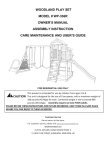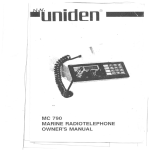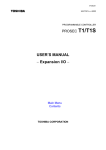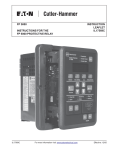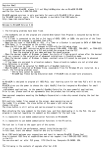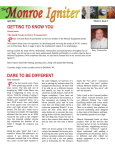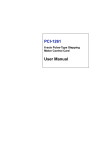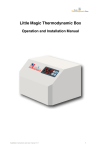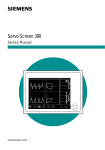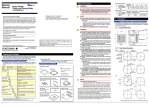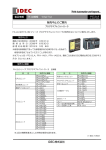Download FA-3S IEC
Transcript
FA-3S SERIES PROGRAMMABLE CONTROLLERS USER’S MANUAL IEC SPECIFICATIONS PF3S-CP11/PF3S-CP11T/PF3S-CP12/PF3S-CP13 FA-3S SAFETY PRECAUTIONS • Read this user’s manual to make sure of correct operation before starting installation, wiring, operation, maintenance, and inspection of the FA-3S programmable controllers. • All FA-3S PLCs are manufactured under IDEC’s rigorous quality control system, but users must add a backup or failsafe provision to the control system using the FA-3S in applications where heavy damage or personal injury may be caused in case the FA-3S should fail. • In this user’s manual, safety precautions are categorized in order of importance to Warning and Caution: Warning Warning notices are used to emphasize that improper operation may cause severe personal injury or death. Caution Caution notices are used where inattention might cause personal injury or damage to equipment. Warning • Turn power off to the FA-3S before starting installation, removal, wiring, maintenance, and inspection on the FA-3S. Failure to turn power off may cause electrical shocks or fire hazard. • Special expertise is required to install, wire, program, and operate the FA-3S. People without such expertise must not use the FA-3S. • Emergency and interlocking circuits must be configured outside the FA-3S. If such a circuit is configured inside the FA-3S, failure of the FA-3S may cause disorder of the control system, damage, or accidents. Caution • Install the FA-3S according to instructions described in this user’s manual. Improper installation will result in falling, failure, or malfunction of the FA-3S. • FA-3S is designed for installation in equipment. Do not install the FA-3S outside of equipment. • Install the FA-3S in environments described in this user’s manual. If the FA-3S is used in places where the FA-3S is subjected to high-temperature, high-humidity, condensation, corrosive gases, excessive vibrations, and excessive shocks, then electrical shocks, fire hazard, or malfunction will result. • The pollution degree of the FA-3S is “Pollution degree 2.” Use the FA-3S in environments of pollution degree 2 (according to IEC664-1). • All DC power type FA-3S units are “PS2” type (according to EN61131). • Prevent the FA-3S from falling while moving or transporting the FA-3S, otherwise damage or malfunction of the FA-3S will result. • Prevent metal fragments and pieces of wire from dropping inside the FA-3S housing. Put a cover on the FA-3S during installation and wiring. Ingress of such fragments and chips may cause fire hazard, damage, or malfunction. • Use a power supply of the rated value. Use of a wrong power supply may cause fire hazard. • Use wires of a proper size to meet voltage and current requirements. Tighten M3.5 terminal screws to a proper tightening torque of 0.8 N-m. • Use an IEC127-approved fuse on the power line outside the FA-3S. This is required when exporting equipment containing FA-3S to Europe. • Use an IEC127-approved fuse on the output circuit. This is required when exporting equipment containing FA-3S to Europe. • Use an EU-approved circuit breaker. This is required when exporting equipment containing FA-3S to Europe. • Make sure of safety before starting and stopping the FA-3S or when operating the FA-3S to force outputs on or off. Incorrect operation on the FA-3S may cause machine damage or accidents. • If relays or transistors in the FA-3S output circuit fail, outputs may remain on or off. For output signals which may cause heavy accidents, provide a monitor circuit outside of the FA-3S. • Do not connect to the ground directly from the FA-3S. Connect a protective ground to the equipment containing FA-3S using an M4 or larger screw. This is required when exporting equipment containing FA-3S to Europe. • Do not disassemble, repair, or modify the FA-3S. • When disposing of the FA-3S, do so as an industrial waste. Dispose of the memory pack in accordance with pertaining regulations (memory packs PFA-1M21, PFA-1M24, and PFA-1M28 contain a battery). IEC SPECIFICATIONS 1 TABLE 2 OF FA-3S CONTENTS Object IEC 1131-2 Subclause See Page in IEC Specifications Manual Total response time(s) formula 4.2.3 User’s Manual EM267 pages A-7 to A-11 Equipment ambient temperature limits Note 3 of 2.1.1.1 5 Relative humidity 2.1.1.3 5 Pollution degree 2.1.1.4 5 Corrosion protection 2.1.1.5 User’s Manual EM267 page 2-1 Electrostatic discharge severity level 2.1.2.2 11 Vibrations 2.1.3.1 5 Special transport and storage conditions 2.3 5 Transport and storage 2.3.6 5 Sizing of a dedicated power source Note 3 of 3.2.1.1 4 and 5 Non-standard power supplies Note 5 of 3.2.1.1 4 Power supply 3.2.3 4 and 5 Additional external load Item 4 of 3.3 12 to 14 A.C. inputs fed from several phases Item 5 of 3.3 13 Non-standard digital I/Os Note 2 of 3.3 12, 13, 15 to 17 Digital inputs 3.3.1.4 12 and 13 Protected/non-protected outputs 3.3.2.2 15 and 16 Short-circuit proof outputs 3.3.2.2 15 and 16 A.C. digital outputs 3.3.2.3 15 D.C. digital outputs 3.3.3.3 15 to 17 Analog inputs 3.4.1.2 14 Analog outputs 3.4.2.2 17 Communication interfaces 3.5.2 9 and 10 MPU, PC configuration 3.6.3 5 and 7 Remote input/output stations 3.7.2 18 Peripherals 3.8.2 18 Noise immunity Note 1 of 3.9.1 11 Noise immunity 3.9.2 11 Insulation properties 3.10.3 4 Self-tests and diagnostics 3.11.3 8 Terminal connections Note 6 of table 26 (4.4.2) User’s Manual EM267 pages 5-1 to 5-6 5 Terminal connections 4.6.3 User’s Manual EM267 pages 5-1 to 5-6 5 Markings 4.12 3 Compliance with this standard 5.4 1 and 6 Safety 5.6 1, 19 to 24 Coverage factors Item 7 of 6.3.2.2 1 IEC SPECIFICATIONS FA-3S PARTS DESCRIPTION Power Indicator (POWER) Operation Indicator (RUN) Turns on when power is supplied to FA-3S. Turns on when FA-3S is running. Error Indicator (ERROR) Turns on when an error occurs in FA-3S. Force Indicator (FORCE) Turns on when forced operations are taking place. Data Bus Connector For connecting remote I/O master station modules, serial interface modules, and high-speed I/O modules. Input Indicators CP12 PSA1 POWER RUN ERROR FORCE N16B A - 01234567 B - 01234567 B - 01234567 IN POWER SUPPLY T16K A - 01234567 1 2 4 8 18 N 100-240V AC B-6 20 NC NC NC A-5 10 A-7 12 +V 9 A-6 11 COM (–) 13 B-0 COM B-4 8 7 A-5 12 16 L A-3 A-4 A-3 NC 14 6 A-2 A-7 B-2 A-1 5 10 B-0 4 3 A-6 NC +V A-1 A-4 MEMORY PACK 2 A-0 A-2 6 1 COM A-0 B-1 15 B-7 5 7 16 B-4 18 B-6 COM (–) 9 11 14 B-5 19 3 B-2 B-3 17 Output Indicators Turn on when the corresponding outputs are on. OUT FA-3S PROGRAMMABLE CONTROLLER Turn on when the corresponding inputs are on. 20 13 B-1 15 B-3 17 B-5 19 B-7 Memory Pack Input Terminals For storing a user program. Available in CMOS-RAM, EPROM, and EEPROM memory packs. For connecting input signals from input devices such as sensors, pushbuttons, and limit switches. Available in 16- and 32-input modules. Output Terminals Power Supply Terminals Loader Cable Connector Connect power supply to these terminals. Power voltage is available in three types: 100-240V AC, 100-120 or 200-240V AC, and 24V DC For connecting the program loader or computer. IEC SPECIFICATIONS For connecting output signals to output devices such as electromechanical relays and solenoid valves. Available in 8-, 16-, and 32-output modules. 3 FA-3S SPECIFICATIONS General Specifications Power Module Rated Power Voltage PF3S-PSA1 PF3S-PSA2 100 to 240V AC 100 to 120V AC 200 to 240V AC PF3S-PSD1 PF3S-EPA1 100 to 120V AC 200 to 240V AC 24V DC –15 to +20% Allowable Voltage Range Dielectric Strength Repetitive Peak Current Input Current Rated Output Power Supply Rated Frequency Power Consumption Allowable Momentary Power Interruption Insulation Resistance Inrush Current Protective Ground Effect of Improper Power Supply Connection Reverse Polarity –15 to +10% –15 to +10% (Additional AC components of ±5% the rated voltage is allowable.) –15 to +10% Between power terminal and FG: 1500V AC, 1 minute Between I/O terminal and FG: 1500V AC, 1 minute 1.5A maximum 1.0A maximum ——— 2.5A maximum 0.4A maximum 0.2A maximum 2.0A maximum 1.0A maximum 12V DC, 1.25A 12V DC, 2.0A 12V DC, 1.7A 24V DC, 1.0A 50/60 Hz 50/60 Hz 50/60 Hz ——— (48 to 63 Hz) (48 to 63 Hz) (48 to 63 Hz) 50 VA maximum 85 VA maximum 32W maximum 85 VA maximum 20 msec max. 20 msec max. 10 msec max. 15 msec max. (maximum load) Level PS-2 (maximum load) (maximum load) Between power terminal and FG: 10 M Ω minimum (500V DC megger) Between I/O terminal and FG: 10 M Ω minimum (500V DC megger) 40A maximum Allowable current: 30A maximum, 2 minutes Grounding resistance: 100 Ω maximum Grounding wire: 2 mm2 minimum No operation, No trouble No trouble No trouble no damage Improper Voltage or Permanent damage may be caused. Frequency Improper Lead Connection Connection failure may be caused. Terminal Arrangement of Power Supply Interface Power Supply Terminals NC NC NC NC NC NC NC GND Switch 2A Fuse L 100-240V AC N NC PF3S-PSA1 Main Power Switch L N Power Supply Terminals NC NC NC NC PF3S-PSA2 Switch 2A Fuse Main Power Switch L N 100-120V AC 200-240V AC 100-240V AC PF3S-PSD1 Main Power Switch Power Supply Terminals NC NC NC NC NC NC GND NC Switch + – 24V DC NC Switch 2A Fuse L 4 Power Supply Terminals NC + – NC PF3S-EPA1 Main Power Switch + 24V DC Power Voltage Selection 100-120V AC: Connect jumper GND 200-240V AC: Remove jumper NC L AC Power N NC N 100-120V AC 200-240V AC IEC SPECIFICATIONS DC Output (24V DC, 1.0A) Power Voltage Selection 100-120V AC: Connect jumper GND 200-240V AC: Remove jumper NC L AC Power N NC FA-3S SPECIFICATIONS General Specifications, continued AC or DC main power must be turned on not later than I/O power. AC or DC main power must be turned off not earlier than I/O power. AC/DC Main Power ON OFF I/O Power ON OFF Power Up/Down Order ≥ 0 sec Backup Duration Battery Super Capacitor Charging Speed Memory Backup Subjects Backup Battery Life Battery Replaceability User Program Storage Operating Temperature Storage Temperature Relative Humidity Pollution Degree Altitude ≥ 0 sec Internal RAM: Approx. 7 days (backed up by a super capacitor) Lithium primary battery (CMOS-RAM memory pack) Approx. 2 hours from 0% to 90% of full charge Data registers, internal relays, shift registers, counters Approx. 7 years (at 25°C) Impossible Memory pack and internal RAM 0 to 55°C (fiber optics parts: –10 to +60°C) –20 to +70°C (fiber optics parts: –20 to +65°C) Relative humidity severity level RH1, 30 to 95% (non-condensing) 2 (IEC 664) Operation: 0 to 2,000m (0 to 6,565 feet) Transport: 0 to 3,000m (0 to 9,840 feet) Vibration Resistance (IEC 68-2-6) 5 to 55 Hz, 60 m/sec2, 2 hours each in 3 axes Shock Resistance (IEC 62-2-27) 300 m/sec2, 11 msec, 3 shocks each in 3 axes Wiring Core wire 0.75 to 1.25 mm2 (AWG18 to AWG16) Input lines must be separated from power, output, and motor lines. M3.5 screw terminal FA-3S must be mounted on a vertical plane. Installation Direction Vertical Plane Mounting Hole Layout 100 (3.937") 4-M4 tapped holes or ø4.5 (0.177") drilled holes 3-slot Base Plate 2-slot Base Plate 3-slot Base Plate 2-slot Base Plate 35 70 35 70 70 (1.379") (2.756") (1.379") (2.756") (2.756") IEC SPECIFICATIONS 5 FA-3S SPECIFICATIONS General Specifications, continued 2-slot Base Module 3-slot Base Module ø4.5 (0.177") Slotted, top only ø4.5 (0.177") Slotted, top only 19 (0.748") 100 (3.937") ø4.5 (0.177") PF3S-CP12 & -CP13 ø4.5 (0.177") 105 (4.134") PF3S-CP11 & -CP11T 111 (4.370") 96 (3.780") 130 (5.118") 130 (5.118") 96 (3.780") 140 (5.512") 140 (5.512") 70 (2.756") 35 160 (6.299") 160 (6.299") (1.378") Module with Double Terminal Block Module with Single Terminal Block 130 (5.118") 96 (3.780") 130 (5.118") 96 (3.780") Dimensions 5 (0.197") 124 (4.882") 130 (5.118") 100 (3.937") 124 (4.882") 130 (5.118") 70 (2.756") 19 (0.748") 35 (1.379") 5 (0.197") 35 118 (4.646") 35 (1.378") 109 (4.291") (1.378") Connector Type I/O Modules Remote Master Station Module 96 (3.780") 35 130 (5.118") 13 (0.512") 145 (5.709") (1.378") Remote Slave Station Module R 35 30 (1.378") (1.181") Program Loader 25.5 (1.004") 35 185 (7.283") 26 (1.024") (1.378") Applied Standard Certified Standard 6 13 3 (0.118") 35 13 (0.512") (1.378") Memory Pack 68 (2.677") 24 (0.945") 112 (4.409") 96 (3.780") 130 (5.118") 26 (1.024") 136 (5.354") 130 (5.118") 96 (3.780") 22 Dimensions in mm (inches). EN61131 EN61131 (TÜV Product Service) IEC SPECIFICATIONS 45 4 (0.866") (1.772") (0.157") FA-3S SPECIFICATIONS Function Specifications CPU Module PF3S-CP11 PF3S-CP11T Program Capacity PF3S-CP12 PF3S-CP13 Memory PF3S-CP11 PF3S-CP12 PF3S-CP13 Backup Function PF3S-CP11T Control System Instruction Words Maximum I/O Points Processing Time Internal Relay Special Internal Relay Data Register Shift Register Timer 10-msec Timer Adding Counter Reversible Counter PF3S-CP11 PF3S-CP11T PF3S-CP12 PF3S-CP13 964 steps (when using 1K memory pack) 3300 steps (when using 4K memory pack) 3300 steps 964 steps (when using 1K memory pack) 4036 steps (when using 4K memory pack) 964 steps (when using 1K memory pack) 4036 steps (when using 4K memory pack) 8072 steps (when using 8K memory pack) CMOS-RAM (backed up by a battery), EPROM, EEPROM A user program is transferred from the program loader to the memory pack. When using CMOS-RAM memory pack: Install a memory pack into the CPU module, and transfer a user program from the program loader to the memory pack installed in the CPU module. The user program in the CMOSRAM memory pack is backed up by a lithium primary battery. The user program and data in the CPU RAM are backed up by an internal super capacitor. When using EPROM or EEPROM memory pack: Install a memory pack into the program loader, and transfer a user program from the program loader to the memory pack installed in the program loader. The user program is written into non-volatile memory in the memory pack. Remove the memory pack from the program loader, and install the memory pack into the CPU module. The user program and data in the CPU RAM are backed up by an internal super capacitor. Transfer a user program from the program loader to the EEPROM in the CPU module (memory pack is not used). The user program and data in the CPU RAM are backed up by a super capacitor and a lithium primary battery. If the data in the CPU RAM is destroyed after a power failure longer than the backup period, an error code is stored when the CPU is powered up. When the lithium battery becomes exhausted, the BATT NG indicator and internal relay M634 go on to signal that the data in the CPU RAM cannot be backed up. If the CPU is powered down at this point, the data in the CPU RAM may be destroyed. Stored program system For details about instruction words, see the FA-3S User’s Manual. Input: 128 points maximum Input: 256 points maximum Output: 128 points maximum Output: 256 points maximum Total I/O: 256 points maximum Total I/O: 512 points maximum 6 µsec/basic instruction (average) 0.3 µsec/basic instruction (average) 1024 points (240 points can be main608 points (240 points can be maintained) tained) 16 points 18 points 32 points 400 points (all points can be maintained) 1000 points (all points can be maintained) 128 points (all points can be maintained) 224 points (all points can be maintained) 80 points 256 points 80 points (advanced instruction T10MS used) 45 points (all points can be maintained) 100 points (all points can be maintained) 2 points (maintained): Dual-pulse reversible and up/down selection reversible counters IEC SPECIFICATIONS 7 FA-3S SPECIFICATIONS Function Specifications, continued PLC Execution Cycle Power ON Interrupt System Initialization Loader Communication Internal Processing A Read Inputs Flow Chart RUN or STOP STOP RUN Internal Processing B Selfdiagnostic Function Execute Program Update Outputs System Initialization Internal Processing A Read Inputs Internal Processing B Execute Program Update Outputs Loader Communication Scanning Process and WDT Power ON Initialize System Keep data sum check Power failure check, WDT (watchdog timer) check, user program sum check Update input data Processed only once immediately after starting to run: User program CRC check, timer/counter preset value CRC check Execute the user program Update outputs User program syntax check, user program writing check Processing A Determination Internal Read Inputs RUN Processing B Execute Program Update Outputs Processing A Determination Read Inputs RUN Scan 1 Update Outputs Processing A Determination Read Inputs RUN Scan N–1 Execute Program Execute Program Update Outputs Scan 2 Update Outputs Processing A Determination Read Inputs RUN Scan N Execute Program Scan N+1 Update Outputs Processing A Read Inputs Scan 3 Processing A Read Inputs Scan N+2 When the scan time is longer than the WDT preset value (500 msec), error indicator ERROR flashes and the PLC stops operation. Basic Instruction Execution Time Total Response Time Effect on Processing Time by physically/ logically connecting/disconnecting nonpermanent peripheral equipment Start/Stop Method Cold Restart Restart Warm Restart Hot Restart Stop/Reset Using External Signal 8 For details, see the user’s manual. PF3S-CP11: 6 µsec PF3S-CP11T: 6 µsec PF3S-CP12: 0.3 µsec PF3S-CP13: 0.3 µsec 8 sec maximum The scan time is extended by a maximum of 5 msec. Turning power on and off. Turning special internal relay M301 (701) and M302 (702) on and off. Possible to restart using a user program Possible to restart using program loader, power supply, or special internal relay Impossible because timer data cannot be maintained Possible using inputs designated by FUN4 and FUN5 as a stop or reset input IEC SPECIFICATIONS FA-3S SPECIFICATIONS Function Specifications, continued Outputs System Statuses during Running, Reset, Stop, and Restart Internal Relays, Shift Registers, Adding Counters (Current Value) Keep Type Clear Type 100-msec Timers (Current Value) 10-msec Timers (Current Value) Reversible Counters C45 and C46 (Current Value) Data Registers Mode Run Reset Stop Restart Run Reset Stop Restart Run Reset Stop Restart Run Reset Stop Restart Run Reset Stop Restart Run Reset Stop Restart Run Reset Stop Restart PF3S-CP11 Operating OFF OFF Unchanged Operating Clear Unchanged Unchanged Operating Clear Unchanged Clear Operating Unchanged Unchanged Reset to preset Operating Unchanged Unchanged Unchanged Operating Unchanged Unchanged Unchanged Operating Reset to zero Unchanged Unchanged PF3S-CP11T Operating OFF OFF Unchanged Operating Clear Unchanged Unchanged Operating Clear Unchanged Clear Operating Unchanged Unchanged Reset to preset Operating Unchanged Unchanged Unchanged Operating Unchanged Unchanged Unchanged Operating Reset to zero Unchanged Unchanged PF3S-CP12 Operating OFF OFF Unchanged Operating Clear Unchanged Unchanged Operating Clear Unchanged Clear Operating Reset to zero Unchanged Reset to preset Operating Reset to zero Unchanged Unchanged Operating Reset to zero Unchanged Unchanged Operating Reset to zero Unchanged Unchanged PF3S-CP13 Operating OFF OFF Unchanged Operating Clear Unchanged Unchanged Operating Clear Unchanged Clear Operating Reset to zero Unchanged Reset to preset Operating Reset to zero Unchanged Unchanged Operating Reset to zero Unchanged Unchanged Operating Reset to zero Unchanged Unchanged Communication Specifications General Name Connection to Program Loader 1:1 Computer Link 1:N Computer Link Cable Conductor Resistance Shield Resistance Slave Stations in 1:N Computer Link Total Cable Length Link Main Unit Link Unit Link Adapter Standard Warning and Caution when Changing Control Status The communication port is used to connect to the program loader, and is also used to set up a computer link system. For details, see 1:1 and 1:N Personal Computer Link System User Manuals. Program channel Using loader extension cable PFA-1A11 Using computer link cable PFA-1A54 Using ø0.9mm shielded twisted-pair cable 85 Ω/km maximum 12 Ω/km maximum 32 slave stations maximum 1.2 km maximum Between FA-3S units: 300m Between computer and link main unit: Approx. 15m PFJ-U22 PFJ-U21 PF2-CLA Compliance with EIA RS485 standard (termination resistor is not needed) Change the control status while the FA-3S is stopped. IEC SPECIFICATIONS 9 FA-3S SPECIFICATIONS Cable Link Main Unit PFJ-U22 Power Voltage Storage Temperature Operating Temperature Indicators Power Consumption Weight 100 to 200V AC +10% to –15%, 50/60 Hz –20 to +70°C 0 to +55°C Power, data transmit, data receive 6 VA Approx. 800g Cable Link Unit PFJ-U21 Power Voltage Storage Temperature Operating Temperature BUSY Indicator Current Draw Weight 12V DC ±10% (supplied from FA-3S) –20 to +70°C 0 to +55°C Stand-by: Dim ON, During communication: Bright ON 120 mA Approx. 250g Cable Link Transmission Transmission System Communication System Communication Mode Transmission Line Transmission Speed Transmission Delay Time Synchronization System Error Check Transmission Procedure Connectable Units Transmission Distance Between computer and cable link main unit: Compliance with RS232C serial interface EIA Between units: Compliance with RS422 EIA One-way, half-duplex 1:N (network communication) 4-core twisted pair cable, ø0.9mm minimum (shielded cable) 9,600 bps Approx. 2.5 µsec (cable length 300m per unit) Start-stop synchronization Even parity, check sum Special 32 units maximum Between computer and cable link main unit: 15m maximum Between units: 300m Link Adapter PF2-CLA Transmission System Communication System Transmission Distance Data Format Operating Temperature Power Voltage Internal Current Draw Weight 10 Compliance with RS232C serial interface EIA 4-wire half-duplex start-stop synchronization Between FA-3S and computer: 15m maximum Baud rate: 9,600 bps Start bit: 1 bit Stop bit: 1 bit Parity: Even parity Data bits: 8 bits Used code: ASCII code (character code) 0 to +55°C 12V DC ±10% (supplied from FA-3S) 20 mA (while communicating between FA-3S CPU module and computer) Approx. 160g IEC SPECIFICATIONS FA-3S SPECIFICATIONS Noise Immunity Specifications Damped Oscillatory Wave Power Terminals I/O Terminals Loader Port Electrostatic Discharge Fast Transient Burst Power Terminals I/O Terminals Loader Port Dielectric Shock Power Terminals Electromagnetic Field Electromagnetic Interference’s FCC EN55022 Serial mode ±2.0 kV minimum ±2.0 kV minimum ±2.0 kV minimum Contact discharge: ±6 kV Aerial discharge: ±8 kV Common mode ±2.0 kV minimum ±2.0 kV minimum ±1 kV minimum (coupling box) Line to line +2.5 kV, –1.5 kV 10 V/m Class A IEC SPECIFICATIONS Line to ground ±2.5 kV 11 FA-3S SPECIFICATIONS Digital DC Input Specifications 24V DC (sink/source input type) 5V DC (sink/source input type) Rated Input Voltage PF3S-N16B PF3S-N32B PF3S-M32K PF3S-N325B PF3S-M325K Input Impedance Input Operating Range ON Area 15 Transition Area OFF Area 5 0 0.5 2 Input Current (mA) ON Area Transition Area OFF Area 3 1.5 0 12.5 2 4 15 Input Current (mA) 2.4 k Ω (24V DC input type), 1 k Ω (5V DC input type) 3 msec maximum 5 msec maximum PF3S-N16B: 16 input points connected in 2 common lines PF3S-N32B and -N325B: 32 input points connected in 4 common lines PF3S-M32K and -M325K: 16 input points connected in 2 common lines Between input terminals: Not isolated Internal circuit: Photocoupler isolated Type 1 (IEC 1131) Not needed Static Input Impedance Turn ON Time Turn OFF Time Input Delay Time Input Impedance 15 Input Voltage (V DC) Input Voltage (V DC) 30 Common and Input Points Isolation Input Type External Load for I/O Interconnection Signal Determination Method Installation/Removal of Modules Permanent damage or malfunction may be caused. while Power is on Effect of Improper Input Connection Permanent damage may be caused. Input Terminal Arrangement and Wiring Diagram PF3S-N16B Source Input – + PF3S-N32B PF3S-N325B PF3S-M32K PF3S-M325K Sink Input + – COM NPN PNP I0 Source Input Sink Input – + + – NC NC I20 I30 NC NC Q0 Q10 NC NC I21 I31 NC NC Q1 Q11 NC NC I22 I32 COM COM I23 I33 I17 I7 I24 I34 I16 I6 I25 I35 I15 I5 I14 I4 I13 I3 COM COM I12 I2 NC NC I11 I1 NC NC I10 I0 NC NC Source Input Sink Input – + + – NC NC Q2 Q12 COM COM Q3 Q13 I17 I7 Q4 Q14 I16 I6 Q5 Q15 I26 I36 I15 I5 Q6 Q16 I27 I37 I14 I4 Q7 Q17 I13 I3 COM COM I1 I2 I3 I4 NPN I5 – + + – PNP I6 NPN PNP I7 NC COM I10 I11 2-wire Sensor – + + – I12 – + + – I13 I14 I12 I2 +V +V I11 I1 NC NC I10 I0 NC NC I15 2-wire Sensor I16 2-wire Sensor Internal Circuit I17 NC Input Input Internal Circuit COM 12 IEC SPECIFICATIONS FA-3S SPECIFICATIONS Digital AC Input Specifications Rated Input Voltage 100V AC and 200V AC (2 types) PF3S-N16A1 PF3S-N16A2 (100V AC Input) (200V AC Input) Input Impedance ON Area 79 Transition Area OFF Area 20 0 Turn ON Time Input Delay Time Turn OFF Time Common and Input Points Isolation Input Type Input Signal Phase External Load for I/O Interconnection Signal Determination Method Installation/Removal of Modules while Power is on Effect of Improper Input Connection ON Area 164 Transition Area OFF Area 40 0 1 2 Input Current (mA) Input Impedance Input Impedance 264 Input Voltage (V AC) Input Operating Range Input Voltage (V AC) 132 11 2 3 Input Current (mA) 10.5 12 k Ω (100V AC input type), 25 k Ω (200V AC input type) 20 msec maximum (100V AC input type) 25 msec maximum (200V AC input type) 20 msec maximum (100V AC input type) 25 msec maximum (200V AC input type) 16 input points connected in 1 common line (16-input module) Between input terminals: Not isolated Internal circuit: Photocoupler isolated Type 1 (IEC 1131) All input signals must be of the same phase. Not needed Static Permanent damage or malfunction may be caused. Permanent damage may be caused. PF3S-N16A1 PF3S-N16A2 COM I0 I1 I2 I3 I4 Input Terminal Arrangement and Wiring Diagram I5 I6 I7 NC NC I10 I11 I12 I13 I14 I15 I16 : Insert a proper fuse. I17 Internal Circuit NC Input Input Internal Circuit COM IEC SPECIFICATIONS 13 FA-3S SPECIFICATIONS Analog Input Specifications PF3S-AD121: PF3S-AD122: PF3S-AD121: PF3S-AD122: Rated Input Range Input Impedance Input Error Maximum Error at 25°C Temperature Coefficient Maximum Error over Full Temperature Range Non-lineality Repeatability after Stabilization Time Monotonicity Digital Resolution Conversion Method Data Format Returned to User Program Conversion Time Total Input System Transfer Time Sample Duration Time Sample Repetition Time Operating Mode Input Value of LSB (Least Significant Bit) Maximum Permanent Allowed Overload (No Damage) Digital Output Reading at Overload Type of Input Common Mode Characteristics Other Inputs Quantity of Inputs Isolation External Load for I/O Interconnection Calibration or Verification to Maintain Rated Accuracy Maximum Temporary Deviation during Electrical Noise Tests and Test Conditions Terminal Arrangement and Wiring Diagram 0 to 10V DC 1 to 5V DC or 4 to 20 mA selectable 2.2 MΩ minimum 2.2 MΩ minimum (voltage input mode) 250 Ω (current input mode) ±0.5% of full scale 0.018 %/°C maximum ±1% of full scale 0.2% maximum 0.5% maximum Yes 4096 increments V/F conversion BCD 2 scans maximum (when scan time is 4 msec or more) 2 scans + 4 msec maximum (when scan time is less than 4 msec) 1 msec maximum 18 msec maximum 1 msec maximum Self-scan PF3S-AD121: 2.4 mV PF3S-AD122: 1.0 mV (voltage input mode), 3.9 µA (current input mode) PF3S-AD121: ±15V PF3S-AD122: ±15V (voltage input mode), ±30 mA (current input mode) 4096 Differential input Common mode reject ratio (CMRR) –80 dB minimum Thermocouples cannot be used. 1 channel Photocoupler isolated Not needed Once within every 6 months The noise test is evaluated on the final equipment. Maximum deviation of the analog input module alone is ±1% of full scale. PF3S-AD121 Connect the shield cable of the analog input signal PF3S-AD122 FG Connect the shield cable of the analog input signal AG AG NC +I +V +V Analog Input Signal –I–V NC 24V DC Power – + NC –15V Connect when using PF3S-MP41 multiplexer module COM 24V DC Power +15V – + +24V 0V Effect of Improper Lead Connection 14 Install a jumper here when using current input Analog Input Signal –V Connect when using PF3S-MP41 multiplexer module FG +15V –15V COM +24V 0V Connecting power supply to the analog input terminal may cause damage. IEC SPECIFICATIONS FA-3S SPECIFICATIONS Digital AC/DC Output (RelayOutput) Specifications Output Protection Without protection Command Output Delay Output Relay Status OFF delay: 13 msec maximum ON delay: 7 msec maximum (including chatter) PF3S-R161 (Relay Output) or PF3S-R081 (Relay Output) or COM Q0 Q0 Q0 Q1 Q2 Q1 Q1 Q3 COM Q2 Q2 Q4 Output Terminal Arrangement and Wiring Diagram Q5 Q3 Q3 Q6 Q7 Q4 Q4 COM Q10 Q5 Q5 Q11 Q12 Q6 Q6 Q13 COM Q7 Q7 Q14 Q15 NC NC Q16 Q17 NC NC : Insert a proper fuse depending on the load. Output Points and Common Lines Relay Contact Rating Relay Output Terminal Ratings Minimum Switching Load Initial Contact Resistance Electrical Life Mechanical Life Effect of Improper Output Connection Output Status by MPU Operatio n Stop Power Interruption over 20 msec Power Interruption over 10 msec up to 20 msec Power Interruption up to 10 msec Power Up PF3S-R161: 16 output points in 4 common lines PF3S-R081: Independent 8 output points PF3S-S161: 16 output points in 2 common lines 240V AC, 2A (Gen/Res) 30V DC, 2A (Gen/Res) 240V AC, 1.5A (AC-15) 1 mA/5V DC (reference value) 50 m Ω maximum 100,000 operations minimum (rated load 1,800 operations/hour) 20,000,000 operations minimum (no load 18,000 operations/hour) When a current larger than the rated current flows, permanent damage such as contact welding may be caused. OFF OFF When using AC power module: ON/OFF status maintained When using DC power module: OFF ON/OFF status maintained OFF until MPU starts to run IEC SPECIFICATIONS 15 FA-3S SPECIFICATIONS Digital DC Output (Transistor Output) Specifications Output Protection Without protection Command Output Status Output Delay OFF delay ON delay 1 msec maximum (PF3S-M32K and -M325K: 3 msec max.) 1 msec maximum (PF3S-M32K and -M325K: 5 msec max.) 12 to 24V DC (PF3S-T325K and -M325K: 5 to 12V DC) 10.8 to 26.4V DC Operating Load Voltage Range (PF3S-T325K and -M325K: 4.5 to 13.2V DC) PF3S-T16K and -T16S: 0.5A per output point, 3.0A per common line Maximum Load Current PF3S-T32K: 0.1A per output point, 0.5A per common line Output Others: 0.1A per output point, 0.8A per common line Terminal 1.5V maximum Ratings Voltage Drop (ON Voltage) (voltage between COM and output terminal when output is on) PF3S-T16K and -T16S: 8.0A Maximum Inrush Current PF3S-T32K: 0.5A Others: 1A PF3S-M32K: 500 µA maximum Leakage Current Others: 100 µA maximum Output Terminal Arrangement and Wiring Diagram Rated Load Voltage PF3S-T16K +V PF3S-T16S +V Q0 Q0 Q1 Q1 Q2 Q2 Q3 Q3 Q4 Q4 Q5 Q5 Q6 Q6 Q7 Q7 COM COM +V +V Q10 Q11 Q12 Q13 Q14 Q14 Q15 Q15 Q16 Q16 Q17 Q17 COM 16 Load Q12 Q13 PF3S-T32K PF3S-T325K Insert a proper fuse. Q10 Q11 NC NC Q20 Q30 NC NC Q21 Q31 COM PF3S-T32S NC NC Q20 Q30 NC NC Q0 Q10 NC NC Q21 Q31 NC NC Q1 Q11 +V +V Q22 Q32 +V +V Q22 Q32 NC NC Q2 Q12 COM COM Q23 Q33 COM COM Q23 Q33 COM COM Q3 Q13 Q17 Q7 Q24 Q34 Q17 Q7 Q24 Q34 I17 I7 Q4 Q14 Q16 Q6 Q25 Q35 Q16 Q6 Q25 Q35 I16 I6 Q5 Q15 Q15 Q5 Q26 Q36 Q15 Q5 Q26 Q36 I15 I5 Q6 Q16 Q14 Q4 Q27 Q37 Q14 Q4 Q27 Q37 I14 I4 Q7 Q17 Q13 Q3 COM COM Q13 Q3 COM COM I13 I3 COM COM Q12 Q2 +V +V Q12 Q2 +V +V I12 I2 +V +V Q11 Q1 NC NC Q11 Q1 NC NC I11 I1 NC NC Q10 Q0 NC NC Q10 Q0 NC NC I10 I0 NC NC IEC SPECIFICATIONS PF3S-M32K PF3S-M325K FA-3S SPECIFICATIONS Digital DC Output (Transistor Output) Specifications, continued Output Points and Common Lines External Current Draw Isolation PF3S-T16K and -T16S: 16 output points in 2 common lines PF3S-T32K, -T32S, and -T325K: 32 output points in 4 common lines PF3S-M32K and -M325K: 16 output points in 2 common lines PF3S-T16K and -T16S: 40 mA maximum per common line PF3S-T32K and -T32S: 25 mA maximum per common line PF3S-T325K and -M325K: 35 mA maximum per common line PF3S-M32K: 20 mA maximum per common line Between output terminal and FG: 1,500V AC Between output terminal and internal circuit: Photocoupler isolated Between output terminals: Not isolated Sink Output Type Source Output Type +V Output Internal Circuit Output Internal Circuit Internal Circuit +V COM (–) Effect of Improper Output Connection Output Status by MPU Operatio n Stop Power Interruption over 20 msec Power Interruption over 10 msec up to 20 msec Power Interruption up to 10 msec Power Up Output COM (–) When a current larger than the rated current flows, permanent damage may be caused on output elements. OFF OFF When using AC power module: ON/OFF status maintained When using DC power module: OFF ON/OFF status maintained OFF until MPU starts to run Analog Output Specifications Rated Output Range Allowable Load Impedance Output Error Maximum Error at 25°C Temperature Coefficient Maximum Error over Full Temperature Range Non-lineality Repeatability after Stabilization Time Monotonicity Digital Resolution Data Format Returned to User Program Total Output System Transfer Time Output Value of LSB (Least Significant Bit) Settling Time after Maximum Range Change Overshoot Maximum Voltage Drop across Output Terminals over Full Output Range Isolation Quantity of Outputs Allowable Load Type Output Ripple 0 to 10V DC or 4 to 20 mA selectable 110Ω maximum (voltage output mode) 270 Ω maximum (current output mode) ±0.5% of full scale 0.018 %/°C maximum ±1% of full scale 0.2% maximum 0.5% maximum Yes 4096 increments BCD 1 msec maximum 2.4 mV (voltage output mode) 3.9 µA (current output mode) 0.5 sec maximum after changing from 0% to 95% 0% 1 LSB maximum Photocoupler isolated 2 channels Resistive load 1 LSB maximum IEC SPECIFICATIONS 17 FA-3S SPECIFICATIONS Analog Output Specifications, continued Output Response at Power Up and Down External Current Draw Calibration or Verification to Maintain Rated Accuracy Maximum Temporary Deviation during Electrical Noise Tests and Test Conditions Power Up: Converted value Power Down: OFF 135 mA maximum Once within every 6 months The noise test is evaluated on the final equipment. Maximum deviation of the analog output module alone is ±1% of full scale. FG AG +V0 Analog Voltage Output –V0 NC NC +I0 Analog Current Output Terminal Arrangement and Wiring Diagram –I0 NC NC +V1 Analog Voltage Output –V1 NC NC +I1 Analog Current Output –I1 NC + 24V DC External Power Effect of Improper Lead Connection – NC +24V 0V Damage may be caused. Remote I/O Specifications Specifications of Cables and Units for Remote I/O Communication Remote I/O System Setup Remote I/O Network Types Data Transfer Capability Communication Speed Remote I/O Timing Diagrams and Delay Data on Structure I/O Modules Incompatible with Remote I/O Redundancy Characteristics and Structure Modem and Repeater Termination Parts Electrical and Mechanical Characteristics of Communication Interface Standard Link Interface Function and Protective Ground Connection/Disconnection Order See FA-3S User’s Manual EM267, chapters 4 and 27. See FA-3S User’s Manual EM267, chapter 27. See FA-3S User’s Manual EM267, chapters 4 and 27. See FA-3S User’s Manual EM267, chapters 4 and 27. See FA-3S User’s Manual EM267, chapter 4. See FA-3S User’s Manual EM267, chapter 27. See FA-3S User’s Manual EM267, chapter 27. PF3S-HSL1 high-speed I/O module cannot be used in Remote I/O. None Modem and repeater cannot be used in Remote I/O. Protection cover (See FA-3S User’s Manual EM267, chapter 27.) See FA-3S User’s Manual EM267, chapters 4 and 27. Original protocol using optical communication Not needed Connection must be done before system power up. Disconnection must be done before system power down. Peripherals Precautions for Changing Control Status Applicability of Peripherals to Remote I/O 18 Stop the FA-3S operation before changing the control status. Impossible IEC SPECIFICATIONS FA-3S ADDENDUM Selecting Fuse against Output Overload and Short-circuitry For Output Circuits of 16-point Relay Output Module PF3S-R161 PF3S-R161 or 2.5A Fuse COM Q0 Q1 Q2 Q3 COM Q4 Q5 Q6 Q7 COM Q10 Q11 Q12 Q13 COM Q14 Q15 Q16 Q17 Insert a fuse of 2.5A per output point on the positive side of each load. Use IEC-approved Time-Lag High-Breaking type fuses. The figure above illustrates a method to comply with EN61131. In practical applications, select a proper fuse depending on the load, and insert the fuse at a proper place. For Output Circuits of 8-point Independent Relay Output Module PF3S-R081 PF3S-R081 or 2.5A Fuse Q0 Q0 Q1 Q1 Q2 Q2 Q3 Q3 Q4 Q4 Q5 Q5 Q6 Q6 Q7 Q7 NC NC NC NC Insert a fuse of 2.5A per output point on the positive side of each load. Use IEC-approved Time-Lag High-Breaking type fuses. The figure above illustrates a method to comply with EN61131. In practical applications, select a proper fuse depending on the load, and insert the fuse at a proper place. 19 IEC SPECIFICATIONS FA-3S ADDENDUM Selecting Fuse against Output Overload and Short-circuitry, continued For Output Circuits of 16-point Transistor Sink Output Module PF3S-T16K PF3S-T16K 630mA Fuse +V Q0 Q1 Q2 Q3 Q4 Q5 Q6 COM (–) Q7 +V Q10 Q11 Q12 Q13 Q14 Q15 Q16 COM (–) Q17 Insert a fuse of 630 mA per output point on the positive side of each load. Use IEC-approved Time-Lag High-Breaking type fuses. When using an inductive load, connect a diode to protect the internal output elements. The figure above illustrates a method to comply with EN61131. In practical applications, select a proper fuse depending on the load, and insert the fuse at a proper place. For Output Circuits of 16-point Transistor Source Output Module PF3S-T16S PF3S-T16S 630mA Fuse +V Q0 Q1 Q2 Q3 Q4 Q5 Q6 COM (–) Q7 +V Q10 Q11 Q12 Q13 Q14 Q15 Q16 COM (–) Q17 Insert a fuse of 630 mA per output point on the positive side of each load. Use IEC-approved Time-Lag High-Breaking type fuses. When using an inductive load, connect a diode to protect the internal output elements. The figure above illustrates a method to comply with EN61131. In practical applications, select a proper fuse depending on the load, and insert the fuse at a proper place. 20 IEC SPECIFICATIONS FA-3S ADDENDUM Selecting Fuse against Output Overload and Short-circuitry, continued For Output Circuits of 32-point Transistor Sink Output Modules PF3S-T32K and PF3S-T325K PF3S-T32K PF3S-T325K CN1 125mA Fuse NC NC CN2 Q20 Q30 125mA Fuse NC NC Q21 Q31 +V +V Q22 Q32 COM COM Q23 Q33 Q17 Q7 Q24 Q34 Q16 Q6 Q25 Q35 Q15 Q5 Q26 Q36 Q14 Q4 Q27 Q37 Q13 Q3 COM COM Q12 Q2 +V +V Q11 Q1 NC NC 125mA Fuse Q10 Q0 NC NC 125mA Fuse Insert a fuse of 125 mA per output point on the positive side of each load. Use IEC-approved Time-Lag High-Breaking type fuses. When using an inductive load, connect a diode to protect the internal output elements. The figure above illustrates a method to comply with EN61131. In practical applications, select a proper fuse depending on the load, and insert the fuse at a proper place. For Output Circuits of 32-point Transistor Source Output Module PF3S-T32S PF3S-T32S CN1 CN2 NC NC 125mA Fuse NC NC Q20 Q30 125mA Fuse Q21 Q31 +V +V Q22 Q32 COM COM Q23 Q33 Q17 Q7 Q24 Q34 Q16 Q6 Q25 Q35 Q15 Q5 Q26 Q36 Q14 Q4 Q27 Q37 Q13 Q3 COM COM Q12 Q2 +V +V Q11 Q1 NC NC 125mA Fuse Q10 Q0 125mA Fuse NC NC Insert a fuse of 125 mA per output point on the positive side of each load. Use IEC-approved Time-Lag High-Breaking type fuses. When using an inductive load, connect a diode to protect the internal output elements. The figure above illustrates a method to comply with EN61131. In practical applications, select a proper fuse depending on the load, and insert the fuse at a proper place. IEC SPECIFICATIONS 21 FA-3S ADDENDUM Selecting Fuse against Output Overload and Short-circuitry, continued For Transistor Sink Output Circuits of 32-point I/O Modules PF3S-M32K and PF3S-M325K Note: The PF3S-M32K has maximum load current ratings of 0.1A per output point and 0.5A per common line. When using at the maximum load, only 5 outputs can be used per common line simultaneously. The PF3S-M325K can use 8 outputs per common line simultaneously at the maximum load. PF3S-M32K PF3S-M325K IN OUT NC NC Q0 Q10 NC NC Q1 Q11 NC NC Q2 Q12 COM COM Q3 Q13 I17 I7 Q4 Q14 I16 I6 Q5 Q15 I15 I5 Q6 Q16 I14 I4 Q7 Q17 I13 I3 COM COM I12 I2 +V +V I11 I1 NC NC 125mA Fuse I10 I0 NC NC 125mA Fuse Insert a fuse of 125 mA per output point on the positive side of each load. Use IEC-approved Time-Lag High-Breaking type fuses. When using an inductive load, connect a diode to protect the internal output elements. The figure above illustrates a method to comply with EN61131. In practical applications, select a proper fuse depending on the load, and insert the fuse at a proper place. For Transistor Sink Output Circuits of High-speed I/O Module PF3S-HSL1 PF3S-HSL1 Note: The PF3S-HSL1 has maximum load current ratings of 0.1A per output point and 0.6A total. When using at the maximum load, only 6 outputs can be used simultaneously. Since the two COM(–) terminals are connected together internally, the PF3S-HSL1 has only one common output line. COM COM (+) (+) I0 I1 I2 I3 I4 I5 I6 I7 NC NC +V +V Q0 Q1 Q2 Q3 Q4 Q5 Q6 Q6 COM COM (–) (–) 125mA Fuse 125mA Fuse Insert a fuse of 125 mA per output point on the positive side of each load. Use IEC-approved Time-Lag High-Breaking type fuses. When using an inductive load, connect a diode to protect the internal output elements. The figure above illustrates a method to comply with EN61131. In practical applications, select a proper fuse depending on the load, and insert the fuse at a proper place. 22 IEC SPECIFICATIONS FA-3S ADDENDUM Selecting Fuse for Power Module For Power Circuits of Standard Power Module PF3S-PSA1 PF3S-PSA1 NC NC NC NC NC NC NC GND 2A Fuse L N 100-240V AC NC Insert a fuse of 2A on the L side of the AC power line. Use IEC-approved Time-Lag High-Breaking type fuses. The figure above illustrates a method to comply with EN61131. In practical applications, select a proper fuse depending on the load, and insert the fuse at a proper place. Grounding the Power Module For the Ground Terminal of Standard AC Power Module PF3S-PSA1 PF3S-PSA1 Connect the GND terminal of the PF3S-PSA1 to a proper ground as described below. A jumper is connected to the seventh NC and eighth GND terminals at the factory. A cable extending from the inside of the housing is connected to the seventh NC terminal. The jumper and cable are fastened with terminal screws. Loosen the GND terminal screw, and connect a grounding wire to the GND terminal. After inserting the wire to the terminal, tighten the terminal screw sufficiently. PSA1 POWER POWER SUPPLY NC Cable from inside NC Connect to ground Grounding resistance 100Ω maximum Grounding wire 2 mm2 minimum GND Jumper L NC L N 100-240V AC NC N IEC SPECIFICATIONS 23 FA-3S ADDENDUM Notes for Using DC Power—SELV (Safety Extra Low Voltage) Power Supply For Power Supply of DC Power Module PF3S-PSD1 PSD1 POWER Use a SELV power supply to supply 24V DC power to DC power module PF3S-PSD1. POWER SUPPLY NC AC 24V DC SELV Power Supply NC + – NC For Power Supply of DC Input and Output Circuits in All DC I/O Modules I/O A - 01234567 B - 01234567 Use a SELV power supply to supply 5 to 24V DC power to DC inputs and outputs of all DC I/O modules. AC 24 SELV Power Supply 5 to 24V DC + – IEC SPECIFICATIONS UNITED STATES IDEC CORPORATION 1213 Elko Drive Sunnyvale, CA 94089-2240, USA Tel (408) 747-0550 Toll Free (800) 262-IDEC Fax (408) 744-9055 Fax (800) 635-6246 E-mail [email protected] www.industry.net/ideccorp JAPAN IDEC IZUMI CORPORATION 7-31, Nishi-Miyahara 1-Chome, Yodogawa-ku Osaka 532, Japan Tel (06) 398-2571 Fax (06) 392-9731 CANADA IDEC CANADA LIMITED Unit 22-151 Brunel Road Mississauga, Ontario, L4Z 1X3, Canada Tel (905) 890-8561 Fax (905) 890-8562 GERMANY IDEC ELEKTROTECHNIK GmbH Wendenstraße 331 D-20537 Hamburg, Germany Tel (040) 25 11 91-93 Fax (040) 254 33 61 UNITED KINGDOM IDEC ELECTRONICS LIMITED Unit 12, Canbury Business Park Elm Crescent Kingston-Upon-Thames Surrey KT2 6HJ, United Kingdom Tel (0181) 549-0737 Fax (0181) 546-0963 HONG KONG IDEC IZUMI (H.K.) CO., LTD. Room No. 1409, Tower 1, Silvercord 30 Canton Road, Tsimshatsui Kowloon, Hong Kong Tel (02) 376-2823 Fax (02) 376-0790 TAIWAN IDEC TAIWAN CORPORATION 3F, No. 75, Hsin Tai Wu Road, Sec. 1 Hsi-Chih, Taipei County, Taiwan Republic of China Tel (02) 698-2601 Fax (02) 698-2709 AUSTRALIA IDEC AUSTRALIA PTY. LTD. 2/3 Macro Court Rowville, Victoria 3178 Australia Tel (03) 9763-3244 Fax (03) 9763-3255 Users Manual #EM324-0 Printed in USA 2.5U 3/97




























